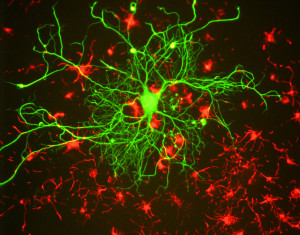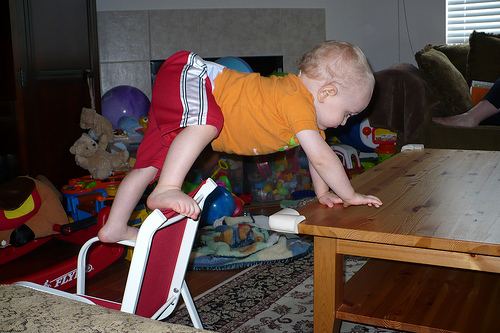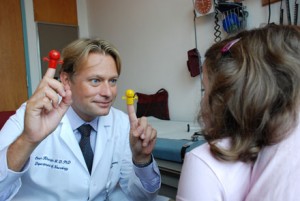
Neuron in tissue culture (Wikipedia creative commons)
Translational neuroscience research has seen a disappointing streak of failed clinical drug trials. While the need for therapeutics that target the nervous system is growing, recent results in diseases like Alzheimer’s and autism have disappointed, and many companies have begun to downsize their R&D investments. Prospects are glum for patients who need new therapies to help manage their disorders.
The frustration is that drug candidates that have shown promise in animal models have not demonstrated efficacy in humans. Mouse models are not proving to be sufficient surrogates for human neurologic disease. Human brains and brain cells are built and function differently, and many neurodevelopmental disorders—hard enough to diagnose in human children—don’t have identifiable behavioral counterparts in mice. As I hear over and over from scientists, there is no such thing as a mouse with autism.
A study, published in Cell Stem Cell this June and conducted by Clifford Woolf, MD, PhD, et al, is among the first to demonstrate the power of an alternative technique: modeling disease in neurons derived from induced pluripotent stem cells (iPS cells). Full story »

Even a small idea, given a small boost, can have a high impact. (Rick Kimpel/Flickr)
When I tell people I work at the Technology and Innovation Development Office at Children’s (TIDO), they usually think I work to commercialize patented blockbuster drug candidates. But many of the most satisfying projects I help promote are innovations that don’t involve as much risk, time and investment, yet make a big difference for patients. Commercializing these innovations can help the greater good, and is part of what propels me to work at a licensing office at a pediatric hospital.
And sometimes it doesn’t take much to help them along.
The Sonnewheel Body Mass Index Calculator and the Vidatak communications board for patients unable to speak or write are some products supported by TIDO without income being the primary goal. Another great example, which we blogged about recently, is helping make routine blood draws less stressful for kids with learning differences and their parents.
The Blood Draw Learning Kit grew out of a serendipitous meeting. Full story »

Chromosome 15. Image: Wikimedia Commons
Angelman syndrome (AS) is a rare, neurogenetic condition characterized by severe developmental delay, movement disorder, speech impairment (often with a complete lack of speech) and an unusually happy demeanor. Nearly every individual with AS faces at least two major challenges in their daily life: cognitive or intellectual disability, and movement disorder, usually in the form of ataxic (uncoordinated) gait, unsteadiness, jerky movements or tremors. Seizures are also common, and present a daunting health challenge.
Arising in one out of every 10,000 to 20,000 children from the loss of an enzyme on chromosome 15 called Ube3A, AS falls in the category of orphan diseases: ones that affect fewer than one in 200,000 Americans. There is no cure for AS, but there are therapies and medications that can help the symptoms. Seizures can be controlled with the right medications, physical therapy can improve ataxia, and speech therapy helps improve communication skills.
Like nearly all orphan diseases, research on AS has historically not been well-funded, but orphan diseases have lately gained growing attention, especially at Children’s Hospital Boston. Full story »
 People with autism and most other disorders of brain development have never had medications to treat their core behavioral and cognitive symptoms. The best they can get are drugs targeting secondary problems, like irritability or aggression. But now, a new wave of clinical trials, such as the one we posted about yesterday for Rett syndrome, aims to change this.
People with autism and most other disorders of brain development have never had medications to treat their core behavioral and cognitive symptoms. The best they can get are drugs targeting secondary problems, like irritability or aggression. But now, a new wave of clinical trials, such as the one we posted about yesterday for Rett syndrome, aims to change this.
In the last decade, scientists have discovered many of the molecular pathways in genetic disorders that can impair cognition and place a child on the autism spectrum—such as tuberous sclerosis complex, Rett syndrome, Fragile X syndrome and Angelman syndrome. These discoveries are suggesting targets for drug treatment, and is changing how these conditions—and perhaps neurodevelopmental disorders generally—are viewed. Full story »

Khwaja evaluates a young girl with Rett syndrome, the leading known genetic cause of autism in girls.
In 2007 an extraordinary paper was published, suggesting that developmental disorders, including autism spectrum disorders, aren’t necessarily a done deal. Working with a mouse model of Rett syndrome, a disorder causing severe cognitive, motor and language problems and autistic behaviors, mostly in girls, researchers in Scotland restored the function of MeCP2, the mutated gene. The mice showed a striking reversal of their neurologic symptoms.
The paper has had an impact around the world, changing how scientists think about disorders that have been thought to be untreatable. Full story »












